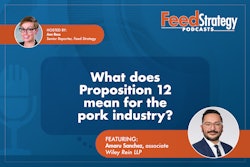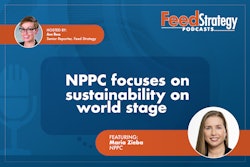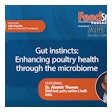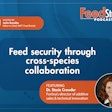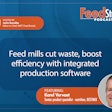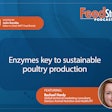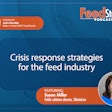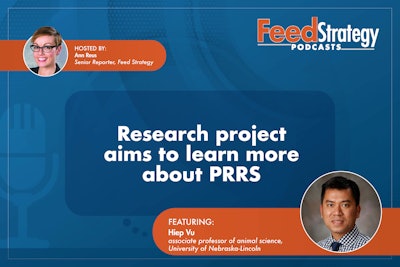
Research project aims to learn more about PRRS (05:43)
Ann Reus: Hello and welcome to the Feed Strategy podcast. I’m your host, Feed Strategy senior reporter Ann Reus.
Hiep Vu is an associate professor of animal science at University of Nebraska-Lincoln, where he is part of a team studying porcine reproductive and respiratory syndrome virus. Also known as PRRS, the disease affects pigs, causing reproductive failure in sows and major respiratory illness in pigs of all ages. The study, which examines how PRRS infects swine macrophages, is funded by a three-year grant from the U.S. Department of Agriculture (USDA).
I recently spoke with Vu, who told me more about the project.
Hello, Hiep. Thanks for being here today.
Hiep Vu: Hi Ann, and thank you for having me.
Reus: You are conducting a research project to examine how PRRS virus infects pig macrophages. Please start by explaining what macrophages are and what they do.
Vu: So, macrophage is a kind of white blood cell, and their main function is to engulf the microbe and destroy them. So, macrophage is a component of our immune system. And because PRRS infects macrophage and kills them, the PRRS virus can weaken the swine immune system.
Reus: Can you tell me more about this project and what exactly you are studying?
Vu: Yes. PRRS are like any other viruses, they must enter a cell to replicate. And so for PRRS, it must enter a macrophage cell. And in order for a virus to enter a cell, it will need to bind to what we call a cellular receptor. And for PRRS, we knew that it requires CD163 to infect the cell, and macrophage have the CD163. That is why the PRRS virus infects macrophages, but what is peculiar is that I recently found a variant of PRRS that do not clearly infect macrophage very well. So it’s still infects, but with very, very low efficiency. And so we want to know why the new variant virus do not infect macrophage that well, even though the macrophages still have the CD163, like I said before.
Reus: So, how far are you into the project and what have you learned so far?
Vu: So we are very, very beginning of the project. And this is funded by USDA, and we have just been into the project for six months only. And like I just described, the key finding is that we have the new variant of virus that do not replicate in macrophage well, and our role is to learn more about this variant virus. Why couldn’t it infect the macrophage very well?
By the way, I forgot to mention that we have two kinds of cells to grow PRRS virus, the swine macrophage and the other cell line we call the monkey kidney cell line. So, the variant virus that I discovered still infect and replicate in monkey kidney cell very well, but it do not replicate in the macrophage. So, we are looking deep into the mechanism, why the variant virus can infect well in the kidney cell, but not in the macrophage so that we hope to learn some difference and understand more about this virus.
Reus: Have any of your findings so far surprised you?
Vu: Yes, the finding that the variant virus replicates well in the monkey kidney cell, but not in the macrophage is a surprise.
Reus: Why study PRRS, specifically, in this way? Can the outcome of the study tell us more about other swine viruses, or viruses in general?
Vu: Yes. So, like I said at the beginning, every virus must enter a cell to replicate. And so, by controlling or by interfering with the cellular entry, we could prevent infection. So that is the reason why we devote the time to study how PRRS virus enters the cell because that is a critical step. And when we study PRRS, we can deal with the same knowledge or technology to learn about other viruses.
Reus: How do you expect to be able to apply this research to vaccine development or other treatment for PRRS or other viruses?
Vu: So for PRRS, because it is an animal virus, so we really focus on vaccine rather than antiviral drug because antiviral drug is not really applicable to swine due to the price. But for vaccine, most of the antiviral vaccine, the target is to prevent the virus from entering the cell because that is a critical step. And so I hope that the results of this study will give us some insight into how we should design the vaccine to prevent the virus infection.
Reus: What are the next steps for this project?
Vu: So, because this is the very beginning of the of the project, we really like look into the way the virus infect the kidney cell, the monkey kidney cell, and the way the virus infect the macrophage. And then we compare between these two processes, and hopefully we learn some new things about this virus.
Reus: I look forward to seeing what you learn here in your study. Thank you so much for being on the podcast.
Vu: Thank you for having me.
Reus: And thank you to the audience for listening. I’m Ann Reus for Feed Strategy.


